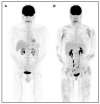The Role of Quantitative and Semi-quantitative [18F]FDG-PET/CT Indices for Evaluating Disease Activity and Management of Patients With Dermatomyositis and Polymyositis
- PMID: 35492313
- PMCID: PMC9051059
- DOI: 10.3389/fmed.2022.883727
The Role of Quantitative and Semi-quantitative [18F]FDG-PET/CT Indices for Evaluating Disease Activity and Management of Patients With Dermatomyositis and Polymyositis
Abstract
Idiopathic inflammatory myopathies (IIM) are considered systemic diseases involving different organs and some subtypes are associated with increased cancer risk. In this review, we provide a comprehensive summary of the current use and potential applications of (semi-)quantitative [18F]FDG-PET/CT indices in patients with IIM focusing on dermatomyositis and polymyositis. Visual interpretation and (semi-)quantitative [18F]FDG-PET indices have a good overall performance to detect muscle activity but objective, robust and standardized interpretation criteria are currently lacking. [18F]FDG-PET/CT is a suitable modality to screen for malignancy in patients with myositis and may be a promising tool to detect inflammatory lung activity and to early identify patients with rapidly progressive lung disease. The latter remains to be determined in large, prospective comparative trials.
Keywords: [18F]FDG-PET/CT; cancer; dermatomyositis; interstitial lung disease; polymyositis; standardized uptake value.
Copyright © 2022 Yildiz, D'abadie and Gheysens.
Conflict of interest statement
The authors declare that the research was conducted in the absence of any commercial or financial relationships that could be construed as a potential conflict of interest.
Figures


Similar articles
-
[18F]FDG-PET/CT in Idiopathic Inflammatory Myopathies: Retrospective Data from a Belgian Cohort.Diagnostics (Basel). 2023 Jul 8;13(14):2316. doi: 10.3390/diagnostics13142316. Diagnostics (Basel). 2023. PMID: 37510060 Free PMC article.
-
Multiple values of 18F-FDG PET/CT in idiopathic inflammatory myopathy.Clin Rheumatol. 2017 Oct;36(10):2297-2305. doi: 10.1007/s10067-017-3794-3. Epub 2017 Aug 22. Clin Rheumatol. 2017. PMID: 28831580
-
Defining the clinical utility of PET or PET-CT in idiopathic inflammatory myopathies: A systematic literature review.Semin Arthritis Rheum. 2022 Dec;57:152107. doi: 10.1016/j.semarthrit.2022.152107. Epub 2022 Oct 18. Semin Arthritis Rheum. 2022. PMID: 36335683
-
[18F]FDG uptake in proximal muscles assessed by PET/CT reflects both global and local muscular inflammation and provides useful information in the management of patients with polymyositis/dermatomyositis.Rheumatology (Oxford). 2013 Jul;52(7):1271-8. doi: 10.1093/rheumatology/ket112. Epub 2013 Mar 11. Rheumatology (Oxford). 2013. PMID: 23479721
-
Intravenous Immunoglobulin in Idiopathic Inflammatory Myopathies: a Practical Guide for Clinical Use.Curr Rheumatol Rep. 2023 Aug;25(8):152-168. doi: 10.1007/s11926-023-01105-w. Epub 2023 Jun 1. Curr Rheumatol Rep. 2023. PMID: 37261663 Review.
Cited by
-
[18F]FDG-PET/CT in Idiopathic Inflammatory Myopathies: Retrospective Data from a Belgian Cohort.Diagnostics (Basel). 2023 Jul 8;13(14):2316. doi: 10.3390/diagnostics13142316. Diagnostics (Basel). 2023. PMID: 37510060 Free PMC article.
-
PET radiomics in lung cancer: advances and translational challenges.EJNMMI Phys. 2024 Oct 3;11(1):81. doi: 10.1186/s40658-024-00685-5. EJNMMI Phys. 2024. PMID: 39361110 Free PMC article. Review.
-
Evaluating CA-125 and PET/CT for cancer detection in idiopathic inflammatory myopathies.Rheumatology (Oxford). 2025 Apr 1;64(4):2115-2122. doi: 10.1093/rheumatology/keae470. Rheumatology (Oxford). 2025. PMID: 39222439
-
18F-FDG PET-CT for the prediction of mortality in patients with dermatomyositis and without malignant tumors: a pilot study.Quant Imaging Med Surg. 2023 Jun 1;13(6):3522-3535. doi: 10.21037/qims-22-1174. Epub 2023 Mar 30. Quant Imaging Med Surg. 2023. PMID: 37284117 Free PMC article.
References
-
- Mariampillai K, Granger B, Amelin D, Guiguet M, Hachulla E, Maurier F, et al. Development of a new classification system for idiopathic inflammatory myopathies based on clinical manifestations and myositis-specific autoantibodies. JAMA Neurol. (2018) 75:1528–37. 10.1001/jamaneurol.2018.2598 - DOI - PMC - PubMed
Publication types
LinkOut - more resources
Full Text Sources

